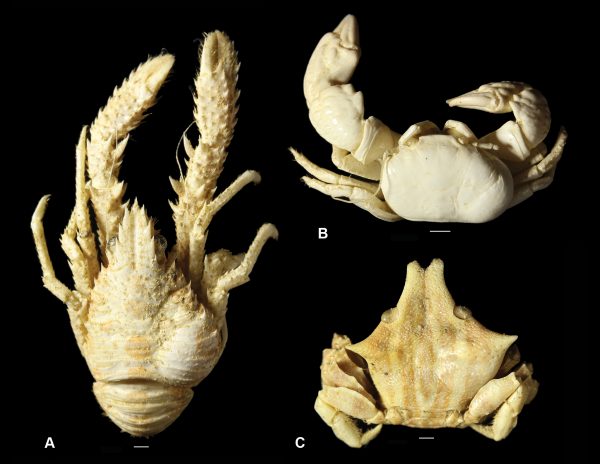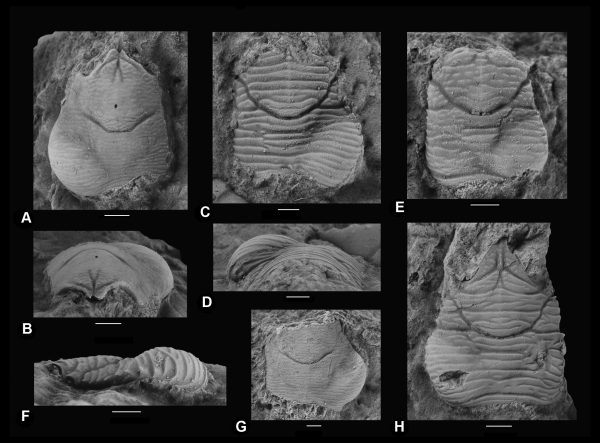
Photo courtesy of Klompmaker et al. (2014) in PLOS ONE
When Darwin suggested the “survival of the fittest” concept, he did not necessarily mean “survival of the biggest.”
The large marine animals of the past, like prehistoric mega-sharks and whales, draw popular attention and the interest of researchers alike. However, the smaller invertebrate animals dominated Earth in the past and still do today.
Florida Museum of Natural History postdoctoral researcher Adiel Klompmaker’s passion lies in studying the small creatures of the deep. It was while collecting specimens of crustaceans at a fossil reef in northern Spain that he noticed a strange swelling on a fossilized crab.
“What is this? Was it sick? Is this a disease of some kind?” wondered Klompmaker. “I had never observed these swellings in the field.”
The culprit was a parasitic isopod crustacean no more than 16 millimeters in size.
The parasitic isopod causes a swelling (Kanthyloma crusta) so noticeable that it survives in the fossil record, though the traces of these “passengers” have not been thoroughly explored until now, Klompmaker said. The isopod parasites latch onto the inner shell of a crustacean, feeding on it and using it as shelter—giving nothing in return.
These tiny animals wreak havoc on a many of today’s crustaceans, fish and other marine life, sometimes resulting in economic losses to fisheries by stunting growth, impairing reproductive abilities and sometimes significantly impacting species diversity.
The order of Isopoda, a name meaning “similar foot” for their many legs, is a diverse group, with more than 10,000 known living species. The order also contains larger isopods that scavenge the bones of whales and other large sea animals whose remains settle on the sea floor. However, in Klompmaker’s study available online and in the March 2014 issue of PLOS ONE, he and co-authors explored isopod infestation since prehistoric times, searching for patterns that may help scientists understand the parasitic infestations of today’s crustaceans.
In a world where big fish eats little fish, the study showed parasitic isopods have found shelter inside their crustacean relatives for 180 million years.
“This is one of the longest histories for parasites in the fossil record,” Klompmaker said. “Parasites are everywhere and they really affect ecosystems. Even though they’re really tiny and don’t seem to do a lot of harm, they influence a large number of species.”

Photo courtesy of Klompmaker et al. (2014) in PLOS ONE
Klompmaker and colleagues collected 874 decapod crustacean specimens in Spain between 2008 and 2012, including crabs and squat lobsters, representing 30 species, 21 genera and 14 families. To create a historical record of infested crustaceans, the scientists also searched literature, databases and museum collections for the bizarre-looking swellings, examining every geological time period.
Scientists relied on traces left behind by ancient isopods in the shell of their decapod hosts, since their soft bodies do not preserve in the fossil record. The swellings occur as the isopod grows, which moves the host’s skeletal parts outward. These fossil swellings typically mean there was a living isopod inside when the crustacean died or molted. The study named a new ichnogenus (ichnotaxa are taxa based on fossil traces of an organism) and species, Kanthyloma crusta, which covers all such isopod swellings.
“We know these swellings from modern crabs,” Klompmaker said. “When you open a crab, you typically see these parasites. In the fossil record, we only have traces of isopods.”
The study found parasite infestation peaked during the Late Jurassic, with 11 percent of all decapods, 20 percent of crab species and 34 percent of squat lobster species infested. Klompmaker said the subsequent drop of isopod parasite infestation during the Cretaceous and Cenozoic may have been caused by adaptations increasing resistance to parasites or drops in diversity of infestation-prone groups.
“Since around 100 million years ago, the number of all decapod species infested has remained stable at about 5 percent,” Klompmaker said. “But this does not reflect what is happening within a species. If you look within a modern species, it may be as high as 60 percent. If economically valuable species are among the 5 percent, then you’ve got a problem.”
A recent example of this is an invasive parasitic isopod from Japan that infested 62 percent of mud shrimp along the Pacific coast of from Baja Calif., to British Columbia. The parasite was introduced in the ’80s and has caused a collapse of this species. This infestation has had an impact both ecologically and economically because the mud shrimp is an ecosystem engineer important to bivalve fisheries, Klompmaker said.
“When humans encounter parasites, they are often on your head or inside of you, then you a take a pill and it’s over soon usually,” Kompmaker said. “If you are a crustacean, it is not that simple.”
Klompmaker said the present levels of isopod infestation follow the “footprint of the past.” By studying the history and patterns of isopod parasite infestation over time, he said researchers hope to better understand patterns of isopod infestation, which could help predict how species may be affected.
“I hope people will start to look more closely at parasite infestation through time,” Klompmaker said. “Much more work is needed to document infestation pattern of decapod faunas and gain more insight into the evolution of parasite infestation in modern decapod crustaceans.”
Learn more about the Invertebrate Zoology Collection at the Florida Museum.